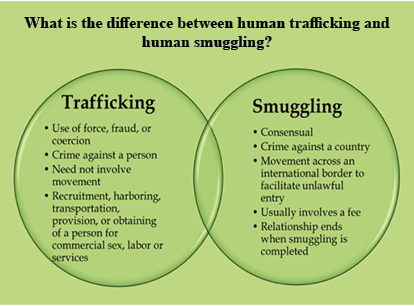 What is Human Trafficking?
What is Human Trafficking?
Human Trafficking is a form of modern-day slavery that involves the use of force, fraud, or coercion to obtain some type of labor or commercial sex act. Inducing a minor into commercial sex is always considered human trafficking, regardless of the presence of force, fraud, or coercion. It is a crime under U.S. federal and international law and is also illegal in all 50 states in the United States. It is always important when speaking of migration to carefully distinguish situations of human smuggling and human trafficking. Although there is often overlap and one can easily bleed into the other, they are conceptually distinct phenomenon. When legal means are not available to migrate, people desperate to leave dangerous or otherwise inhospitable situations in their home countries will often migrate using irregular routes.
Due to the clandestine nature of this crime, human trafficking is difficult to quantify and an underreported problem. The estimated number of victims actively trapped in a human trafficking situation worldwide is uncertain, as is the number of people involved in perpetrating this crime. Estimates vary widely, recognizing that perpetrators of this crime often find new tactics, methods, and means to exploit individuals, there is still much unknown about the crime. Some statistics according to the Global Slavery Index, the report revealed that there are 1.1 million people (about the population of Montana) trapped in situations of forced labor, and sexual exploitation in the United States. Moreover, in 2021, it was reported that an estimated 49.6 million people (about twice the population of Texas) were living in situations of modern-day slavery in any given day in around the world.
Human trafficking can take a variety of forms. Some people are trafficked for prostitution, pornography, and other forms of sexual exploitation. Some are trafficked for forced labor in agriculture, sweat shops, and domestic servitude. Some are trafficked for both. Through sexual slavery, the body becomes little more than an object to be exploited. For victims of forced labor, the body is made into a disposable machine, made to work long hours for little or no pay and for the profit of others. In both cases the person who is enslaved is treated as an object for another’s benefit. The person’s God-given human dignity is either ignored or forgotten.
